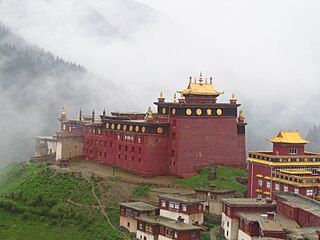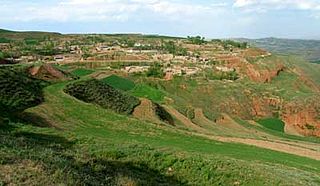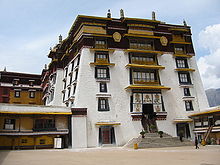
Lhasa, officially the Chengguan District of Lhasa City, is the inner urban district of Lhasa City, Tibet Autonomous Region, Southwestern China.

The Potala Palace is a dzong fortress in Lhasa, capital of the Tibet Autonomous Region in China. It was the winter palace of the Dalai Lamas from 1649 to 1959, has been a museum since then, and a World Heritage Site since 1994.

Rumtek Monastery, also called the Dharma Chakra Centre, is a gompa located in the Indian state of Sikkim near the capital Gangtok. It is the seat-in-exile of the Gyalwang Karmapa, inaugurated in 1966 by the 16th Karmapa. It is also a focal point for the sectarian tensions within the Karma Kagyu school of Tibetan Buddhism that characterize the 17th Karmapa controversy.

The Jokhang, or the Ra sa 'phrul snang gtsug lag khang, or Qoikang Monastery, or Zuglagkang,, is considered the "heart of Lhasa". The Jokhang consists of a Tibetan Buddhist temple, its temple complex, and a Gelug school monastery. Located in Barkhor Square, it was built in c.640 by King Songsten Gampo to house the Jowo Mikyo Dorje, a statue of Akshobhya Buddha, brought to Tibet by his Nepalese queen, Bhrikuti. Another statue, the Jowo Shakyamuni, brought by his Tang Chinese queen Wencheng, is currently housed in the temple and the Jowo Mikyo Dorje is housed in the Ramoche, in Lhasa.

Düsum Khyenpa was the 1st Gyalwa Karmapa, head of the Karma Kagyu school of Tibetan Buddhism.

The sixteenth Gyalwa Karmapa, Rangjung Rigpe Dorje was the spiritual leader of the Karma Kagyu lineage of Tibetan Buddhism. Followers believed him to be part of the oldest line of reincarnate lamas in Vajrayana Buddhism, known as the Karmapas, whose coming was predicted by the Buddha in the Samadhiraja Sutra. The 16th Karmapa was considered to be a "living Buddha" and was deeply involved in the transmission of the Vajrayana Buddhism to Europe and North America following the Chinese invasion of Tibet. He had many monikers, including "King of the Yogis", and is the subject of numerous books and films.

Tibet developed a distinct culture due to its geographic and climatic conditions. While influenced by neighboring cultures from China, India, and Nepal, the Himalayan region's remoteness and inaccessibility have preserved distinct local influences, and stimulated the development of its distinct culture.

The Palcho Monastery or Pelkor Chode Monastery or Shekar Gyantse is the main monastery in the Nyangchu river valley in Gyantse, Gyantse County, Shigatse Prefecture, Tibet Autonomous Region. The monastery precinct is a complex of structures which, apart from the Tsuklakhang Monastery, also includes its Kumbum, believed to be the largest such structure in Tibet, that is most notable for its 108 chapels in its several floors and the old Dzong or fort.

Tsurphu Monastery (Tibetan: མཚུར་ཕུ་དགོན་པ or Tölung Tsurphu is a gompa which serves as the traditional seat of the Karmapa, the head of the Karma Kagyu lineage of Tibetan Buddhism. It is located in Gurum in Doilungdêqên District, Tibet Autonomous Region, China, 70 kilometres from Lhasa.

Palpung Monastery is the name of the congregation of monasteries and centers of the Tai Situpa lineage of the Kagyu school of Tibetan Buddhism as well as the name of the Tai Situ's monastic seat in Babang, Kham. Palpung means "glorious union of study and practice". It originated in the 12th century and wielded considerable religious, political, and economic influence over the centuries.
This is a list of topics related to Tibet.

Tibetan Buddhist architecture, in the cultural regions of the Tibetan people, has been highly influenced by Nepal, China and India. For example, the Buddhist prayer wheel, along with two dragons, can be seen on nearly every temple in Tibet. Many of the houses and monasteries are typically built on elevated, sunny sites facing the south. Rocks, wood, cement and earth are the primary building materials. Flat roofs are built to conserve heat and multiple windows are constructed to let in the sunlight. Due to frequent earthquakes, walls are usually sloped inward at 10 degrees.

Taktser or Tengtser or Hongya Village is a village in Shihuiyao Township, Ping'an District, Haidong, in the east of Qinghai province, China. Tibetan, Han and Hui Chinese people populate the village which is notable as the birthplace of the 14th Dalai Lama, Tenzin Gyatso.

Kumbum Monastery, also called Ta'er Temple, is a Tibetan gompa in Lusar, Huangzhong County, Xining, Qinghai, China. It was founded in 1583 in a narrow valley close to the village of Lusar in the historical Tibetan region of Amdo. Its superior monastery is Drepung Monastery, immediately to the west of Lhasa. It is ranked in importance as second only to Lhasa.

Pema Dönyö Nyinje is the 12th Tai Situpa, a tulku in Tibetan Buddhism, and one of the leading figures of the Karma Kagyu school. He is the head of Palpung Monastery.

Buddhism in the Himachal Pradesh state of India of has been a long-recorded practice. The spread of Buddhism in the region has occurred intermediately throughout its history. Starting in the 3rd century BCE, Buddhism was propagated by the Maurya Empire under the reign of Ashoka. The region would remain an important center for Buddhism under the Kushan Empire and its vassals. Over the centuries the following of Buddhism has greatly fluctuated. Yet by experiencing revivals and migrations, Buddhism continued to be rooted in the region, particularly in the Lahaul, Spiti and Kinnaur valleys.
Sershul Monastery is situated on the Tibetan Plateau at an elevation of 4,000 metres (13,000 ft). The Tibetan Buddhist monastery is located near Waxu township in Sêrxü County of the Garzê Tibetan Autonomous Prefecture of Sichuan Province, near where the borders of the Tibet Autonomous Region and Qinghai Province meet.

Lhasa is noted for its historic buildings and structures related to Tibetan Buddhism. Several major architectural works have been included as UNESCO's World Heritage Sites.

Although there were many householder-yogis in Tibet, monasticism was the foundation of Buddhism in Tibet. There were over 6,000 monasteries in Tibet. However, nearly all of these were ransacked and destroyed by Red Guards during the Cultural Revolution. Most of the major monasteries have been at least partially re-established, while many others remain in ruins.



















